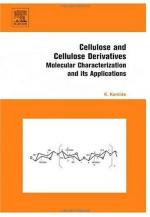|
This section contains 327 words (approx. 2 pages at 300 words per page) |
Cellulose is a polymer of glucose, and is formed by plants, fungi, and algae. Cellulose is the principal component of the plant cell wall, and provides the raw material for a wide variety of plant-based industries.
Cellulose forms ribbon-like chains, each composed of thousands of glucose molecules bonded together end to end. These chains are linked together by a network of hydrogen bonds, allowing cellulose to form microfibrils, which are themselves linked by non-cellulose molecules to form the cell wall. The plant cell membrane is enclosed within this meshwork of cellulose.
Cellulose is a principal component of wood, flax, hemp, jute, and other plant products used for fuel or fiber. Cotton is virtually pure cellulose. during paper manufacture, wood is processed to remove much of the non-cellulose material, leaving the pulp, whose fibers are then pressed and dried to make the paper.
Although both starch and cellulose are pure glucose, a slight chemical difference between the two prevents humans from digesting cellulose, but allows us to obtain energy from starch. As in starch, glucose molecules in cellulose are linked by dehydration between the 1 position of one glucose ring and the 4 position of the next. However, in cellulose, the geometric orientation of the H and OH at the 1 position differ from those in starch, and as a result, the linkage takes on a different shape. This so-called beta-1,4 bond cannot be broken by starch-digesting enzymes, and in fact cannot be broken down at all by animals. Fungi, certain protozoans, and some bacteria do contain cellulose-digesting enzymes, called cellulases. These organisms form the important class of decomposers within the food web, without which cellulose would continue to accumulate in the environment. Termites host some species of cellulose-digesting protozoans in their gut, allowing them to use wood as a food source. Cows and other ruminants employ the same strategy. Humans have no such organism in their digestive systems, and as a result, cellulose passes through the intestines unchanged.
|
This section contains 327 words (approx. 2 pages at 300 words per page) |


